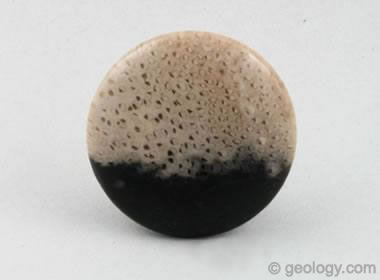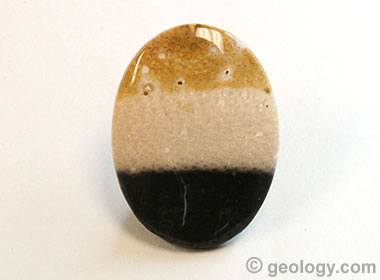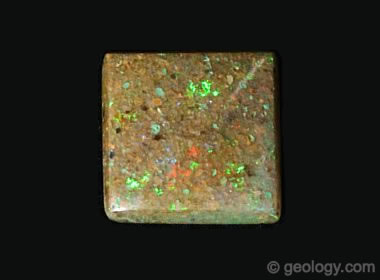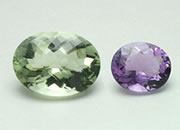Home » Gemstones » American Gemstones » Louisiana
Louisiana Gemstone Mining
Petrified palm wood is found in Louisiana, along with a unique variety of precious opal.
Author: Hobart M. King, PhD, GIA Graduate Gemologist

Louisiana palm: An oval cabochon cut from Louisiana palm. The face of the cabochon was cut parallel to the trunk of the palm. The lines represent the vascular structure of the plant. The cabochon is about 57 x 33 millimeters in size.
Gemstones in Louisiana?
Louisiana is a state whose surface geology is dominated by sediments and sedimentary rocks. There are no outcrops of metamorphic rocks, none of igneous rocks, and the state is not at all known to be a great place to find minerals.
In spite of that, Louisiana has been the source of a few gemstones - notably, its petrified plants, a small occurrence of very unique opal, and even the reported find of an 18.2-carat gem-quality diamond.
Table of Contents
 Louisiana "Palm Wood" Louisiana "Palm Wood" Louisiana Opal Louisiana Opal Opalized Palm Opalized Palm The Mounce Diamond The Mounce Diamond |

Louisiana palm: A round cabochon cut from Louisiana palm. The face of the cabochon was cut perpendicular to the trunk of the palm. The dots are cross-sections through the vascular tubes of the palm. The cabochon is about 29 millimeters in diameter. The Louisiana palm cabochon at the top of this page and the one immediately above were cut by Tom Wolfe of Wolfe Lapidary.
Louisiana "Palm Wood"
The most widely known Louisiana gem material is the Oligocene-age "petrified wood" that is found in the Catahoula Formation, a sedimentary rock unit that was deposited on the alluvial plains and in the coastal swamps of the Oligocene Gulf Coast.
At that time, the coastline was about 100 miles farther inland than it is today. Sediments shed, mainly from the uplift of the Rocky Mountains, have since built the coastline seaward to its current position.
|
Most specimens are a palm of the genus Palmoxylon, which has been named as the state fossil of Louisiana. Palmoxylon did not produce a true "wood" composed of cellulose and lignin. Instead it was a plant that looked similar to a modern palm tree with a trunk made up of parenchyma, a fibrous support material that surrounded hollow tubes of the plant's vascular structure known as xylem and phloem. These tubes transported water, nutrients, wastes, and other materials through the plant. [1]
When the palm died, it had an opportunity to be preserved as a fossil if it was quickly covered by water and sediments that would protect it from oxidation and destructive organisms. Ground water flowing through the sediments carried dissolved silica that sometimes precipitated within the hollow xylem and phloem to preserve them. The silica would also replace the fibrous parenchyma. This infilling and replacement of the plant structures with solid silica produced the fossil known as "petrified palm."
Today, fossilized palm trunks and fragments are found at many locations in Louisiana, Texas, and Mississippi, where the Catahoula Formation is exposed at the surface. Pieces of this material that are completely and uniformly silicified are often of high enough quality to be cut, polished, and used as the dome-shaped gems known as cabochons. It is also used to make small sculptures, spheres, book ends, and other ornamental objects.
When the material is cut along the length of a palm trunk, the tubes of the vascular structure often have an appearance that resembles wood grain. When it is cut perpendicular to the palm trunk, the tubes of the vascular structure often display as an array of "dots." Cabochons cut from wood slices sawn in these orientations are shown in the photos on this page.

"Petrified palm": An oval cabochon cut from Louisiana palm with three colors of chalcedony. This stone measures about 40 millimeters x 30 millimeters in size.
Louisiana palm fossils can be colorful. They typically range in color from white to honey brown or from chocolate brown to black. Red, orange, and pink colors are also found. The material is usually a chalcedony, but some occurrences of opalized palm are known.
"Petrified palm" is an attractive material that represents a time in the geologic history of Louisiana. It is also attractive enough and abundant enough to be widely known, and for those reasons it was named as Louisiana's state fossil.
Hunt For Gems - Keep What You Find!There are over 100 mines in the United States where anyone can visit, pay a small fee, look for gems and minerals, and keep what they find. For a large list of these mines, visit our Fee Mining Page on RockTumbler.com. |

Louisiana opal: A square cabochon cut from sandstone found in Vernon Parish, Louisiana, that is cemented with precious opal. A play-of-color is produced by the interstitial cement when the cabochon is moved under incident light. The cabochon measures approximately 20 x 20 millimeters in size.
Louisiana Opal
Small amounts of a material called "Louisiana Opal" or "Louisiana Sand Opal" have been mined from the Catahoula Formation near Leesville, Vernon Parish, Louisiana. If you examine this material closely, you will find that it is a sandstone in which the sand grains are bound together by a cement of clear precious opal. [2]
When this sandstone is completely cemented, solid, and unweathered, it is stable enough to be slabbed, cut into cabochons, and polished to a bright finish. When a polished cabochon is played in incident light, the interstitial opal can produce small patches of play-of-color.
The material is not spectacular in appearance, but it is a genuine precious opal. It is a novelty gem that is enjoyed by local people and gemstone collectors. Small amounts of this material were produced in the late 1980s and early 1990s. It is no longer produced, and rough material is difficult to find.
In addition to cabochons, lapidarists have used Louisiana Opal to produce spheres and other objects. Most of the material has a brown base color like the 20mm x 20mm cabochon shown in the photo above. It also occurs with a gray to black base color. The play-of-color is much easier to see in specimens with the darker base colors.
Opalized Palm
Much of the "petrified palm" found in the Catahoula Formation, as described on this page, has actually been opalized rather than agatized. Some of this common opal exhibits a "grain" that is a preservation of the palm's vascular structure. It can be easily identified as opal because its Mohs Hardness is 5.5 to 6, compared to the Mohs Hardness of 7 that would identify it as chalcedony. The opalized specimens polish as nicely as the agatized specimens, but the polished surface has a more "waxy" luster compared to the "vitreous" luster of agatized material.
| Louisiana Gemstone Information |
|
[1] Palmoxylon of the Catahoula Formation: by Mike Viney, article published on The Virtual Petrified Wood Museum website. Hosted on the Internet Archive.
[2] Opal, Louisiana: by John Sinkankas, in Gemstones of North America, Volume III, pages 246-247. [3] Large Diamond Found in Louisiana: A Gemological Digest article published in the Winter 1969-1970 issue of Gems & Gemology, last accessed October 2022. |
The Mounce Diamond
In 1969 a boy playing in his yard in the community of Princeton, Louisiana found an interesting crystal. His family suspected that it was a diamond, so his father showed it to several jewelers in the city of Shreveport. His father was eventually directed to C. E. Mounce, a jeweler with gemological training. Mounce identified the item as an 18.2-carat diamond crystal in the form of a modified octahedron and purchased it from the boy's father.
Mounce later sent the crystal to a New York City diamantaire who cut the crystal into 3 faceted stones: a 3.47-carat oval, a 2.27-carat marquis, and a 2.75-carat heart shape. The geological source of the diamond remains unknown, and no nearby diamond deposits have ever been discovered. [3] It was likely an alluvial diamond.
| More Gemstones |
 |
Birthstones |
 |
Gifts That Rock |
 |
Diamond |
 |
Polka Dot Agate |
 |
Prasiolite |
 |
Bloodstone |
 |
Blue Gemstones |
 |
Tourmaline |

Find Other Topics on Geology.com:

|

| ||

|

| ||

|

| ||

|

|
